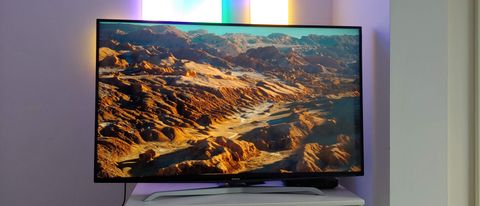TechRadar Verdict
Polaroid's budget-orientated P49UPA2029A has a feature list as long as your arm. It's a decent set for the price – but don't expect Dolby Vision performance of the calibre you'd find in a premium television.
Pros
- +
Great feature set
- +
Good price point
- +
A wealth of smart options
Cons
- -
Dolby Vision underwhelms here
- -
Lackluster upscaling
- -
Buzzing issue with screen mirroring
Why you can trust TechRadar
Dolby Vision, 4K HDR visuals and integrated smart services. These were once the reserve of super-luxurious high-end televisions. But as technologies mature, so too do their prices, and a new range of LCD Polaroid TVs looks to bring these sort of headline features to an affordable price point.
The Polaroid P49UPA2029A 49-inch 4K HDR TV boasts Dolby Vision support, a nifty range of streaming apps and Alexa integration, with a price tag that won’t break the bank. It comes with some compromises as you’d expect from the budget nature of the set – but not so many to deter those on a tight budget.
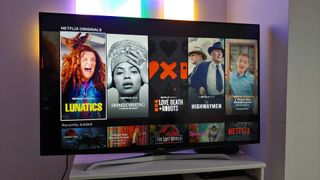
Price and availability
The Polaroid P49UPA2029A 49-inch 4K HDR TV will be available from 27 April 2019, exclusively to UK Asda stores, and online at www.george.com. It’ll cost you £349, however, 43- and 55-inch models are also available, priced at £299 and £399 respectively.
These are very reasonable prices given the feature lists associated with the range, but bear in mind that not all TV panels and chipsets are created equally, and that despite the presence of Dolby Vision, this remains a budget-oriented set in terms of both price and performance.
Design
If you’re after a slick and slim TV, the Polaroid P49UPA2029A isn’t it: It’s a chunky set, with a notable border around the display. It sits on a silver two-pronged foot that raises the screen slightly off a surface. It can of course be wall mounted, too, but note that it’s going to protrude a few inches from the wall. It’s not an unattractive design for a budget set, but it’s breaking no barriers, either.
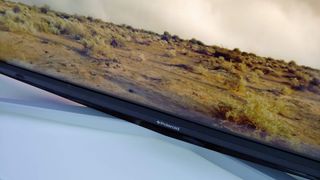
In terms of connectivity, you’ve got three 4K HDR compatible HDMI 2.0 ports (two side – one being ARC – and one back), two USB ports, composite audio and video, digital audio via an optical connection, a headphone and a line out port, as well as a LAN connection if your Wi-Fi isn’t up to scratch.
The remote control is comfortable to use, if a little long. You’ve got dedicated buttons for Netflix, Amazon Prime, YouTube and Freeview Play, as well as a small selection of playback controls along the bottom.

A few minor complaints about the remote – it uses a pair of less-prevalent AAA batteries over AA, which can be harder to find, and its navigation ring flashes with light when a button is pressed. It does nothing to illuminate the remote in darker viewing scenarios, and only acts to drain the battery, with no option of turning the feature off.
It’s a safe design – totally inoffensive (if a bit thick), but uninspiring.
Smart TV
The Polaroid P49UPA2029A does well with its smart and connected offering. Not only does it ship with Freeview Play built in (being the most fully-featured, catch-up orientated EPG guide you’ll find in a UK TV), but with the full suite of streaming apps you’d hope to find on a smart TV, including Netflix, Amazon Prime Video, iPlayer, Rakuten TV, YouTube and more.
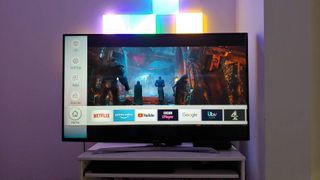
While we’ll talk about their performance in a bit more depth shortly, what’s best is that they’re the 4K and HDR-enabled versions of the respective apps, and in the case of Netflix, the Dolby Vision-enabled version too.
There are a number of other apps of varying quality and usefulness included from the set’s app store, including Facebook and Twitter and a handful of simple games. But they’re the sort of thing you’ll probably have mobile alternatives for, better suited to a different device’s form factor.
On the whole, the interface for the screen is easily navigated and legible. Set up is simple, and the TV’s (seemingly bespoke) interface is sensibly laid out. You’ve got a cross-bar menu column to scroll through, with each row offering up individual settings and options, from sources to apps. There’s a customisable app shortcuts bar too, letting you quickly find your most-used streaming sources, for instance.
What does appear annoying however is a lack of consistency with the Home button – in our testing, in some instances it will bring up the main menu, in others it won’t register at all, and others it will leave an app entirely. It’s a bit pot luck, which is a shame considering the simplicity elsewhere.

Certain elements of the interface feel very snappy indeed, while others feel sluggish. Set-up, for instance, was a breeze, with button pushes registered instantly. But scrolling through Netflix’s rich-media menus can cause delays that lead to you making additional unwarranted button presses, passing by the content you actually wanted.
It was pleasing to find that the TV had a screen mirroring option for mobiles too, which connected to an LG G7 without a hitch. However, when using this mode, the TV made a regular, disconcertingly loud and short buzzing sound, which may make you wary of spending too much time with it.
If you want to get a web browser going natively on the display, there are two browsers built in (one Google-built), but the remote control isn’t suitable for navigating them at anything but a laborious speed.
The screen also supports Alexa voice control integration, pairing up with the Amazon Echo speaker family. It’s a feature that wasn’t available to play with during the pre-release window within which we tested the TV however – we’ll update this review once we’ve given it a go, but it’s another welcome feature that show’s Polaroid has, at the very least, worked hard to put together a competitive feature list.
Performance
It’s a tale of two halves for the Polaroid. If you’re diving in for purely for 4K content, you’ll be pleasantly surprised so long as you manage expectations. But the performance of the standard and high-definition imagery leaves a lot to be desired.
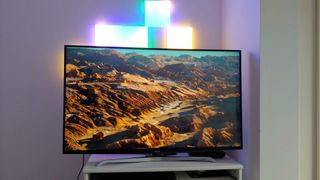
First then, the good. The Polaroid panel handles native 4K sources rather well. While colors and black levels can appear muted, the panel does a good job of delivering crisp imagery, and doesn’t struggle too much with motion, delivering a relatively smooth scene without its motion processing resorting to an unnaturally watery presentation.

Netflix’s Our Planet makes for a good test case, full of vibrant colours, and busy natural scenes, as well as being a Dolby Vision HDR title as the Polaroid is capable of displaying.
Imagery can get a little noisy when too much action is occurring on screen, as when a school of fish sweeps through an azure scene, but hit one of the show’s more sedate landscapes and it’s detailing can be rather wonderful given the budget nature of the set.
But does it really do that Dolby Vision badge justice? We’d argue no – the peak brightness just doesn’t seem powerful enough to deliver the twinkling shimmers the HDR technology can offer, and has none of the impact you’d see from a premium panel that would push Dolby’s superb technology to its limits.
The screen makes a good showing of itself for gaming too. Input lag will appear imperceptible to the average gamer, with a 4K source again moving and displaying crisply. Hooking up a gaming PC for a few hours of Borderlands 2 was highly enjoyable, taking advantage of the games’ boisterous colour scheme.
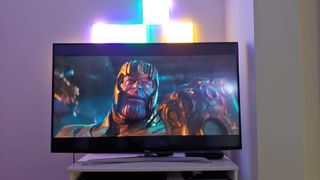
When you make the jump to source of a lower resolution than 4K though, things start to get a bit messy.
It’s not unwatchable by any stretch, and if you’re settling down to watch your favourite soap of news station, you’ll be satisfied. But watching a HD recording of Avengers: Infinity War, with a Sky Q box as the source, it was a bit disappointing.
The opening scene, where Thanos takes on a bloodied Thor and Hulk, offered none of the dynamism in contrast between space and flame that makes that scene come to life, while details looked smeared by the set’s upscaling attempts.
Sound
As you’d expect from a TV of this price, audio quality isn’t high on its list of priorities. But, having said that, considering there’s just a stereo pairing of 2x10W speakers onboard, the Polaroid P49UPA2029A performs perfectly acceptably.
There are of course ample ways to hook up superior speakers to the set, but it’s extra thickness gives its sound a little more body than you might expect.
Dolby Audio modes, tuned for music, movie and news broadcasts, as well as Dynamic Bass and DTS TruSurround options, give you some settings to tinker with to find a mix to fit what you’re viewing.
But as with most flatscreen TVs, don’t expect the performance to be a match for a dedicated soundbar.
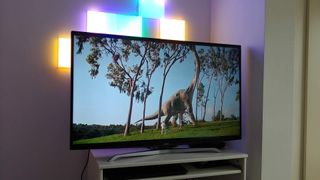
Verdict
For the price tag, the Polaroid P49UPA2029A is an ambitious budget set. Its suite of smart connectivity features, from Alexa integration (when it appears) to myriad streaming options, should be applauded, as is the attempt to get Dolby Vision visuals into a screen of this price.
However, while it’s an admirable effort, you do, as the old adage goes, get what you pay for. It’s a feature-rich set, but cough up a little more cash and you’ll see the significant improvements in image quality and connectivity elsewhere.
We've reviewed this TV on whether it deserves the prime position in your living room, even if your budget can only stretch so far, and on that it comes up short.
But if you’re a sucker for ticking off checkboxes on features, and aren't going to be stress-testing the picture quality regularly, the Polaroid P49UPA2029A will make a welcome secondary set for elsewhere in your home.
All image credits: TechRadar
- Best TV 2019: which TV should you buy for bigscreen action?
Gerald is Editor-in-Chief of iMore.com. Previously he was the Executive Editor for TechRadar, taking care of the site's home cinema, gaming, smart home, entertainment and audio output. He loves gaming, but don't expect him to play with you unless your console is hooked up to a 4K HDR screen and a 7.1 surround system. Before TechRadar, Gerald was Editor of Gizmodo UK. He is also the author of 'Get Technology: Upgrade Your Future', published by Aurum Press.
